As acrylic painters we thin our paints with water to lower viscosity and make thin washes. Many of us also use mediums to alter consistency and viscosity and make translucent glazes. But, it is not always obvious how and when to use these mixtures, or how versatile they can be. Acrylics’ natural versatility allows for a wide range of uses for both, and this article seeks to describe the differences, similarities, characteristics and attributes of washes and glazes, and when one might be better or more useful than the other.
The primary similarity between washes and glazes is the translucent color effects possible with both, which allows the undertone of the color to show itself. Typically, washes soak into a surface, while glazes sit on top. Most of the washes and glazes shown here were made with about 1 part paint to about 90 parts water or medium, but there is a wide range of ratios possible.
What are Acrylic Washes?
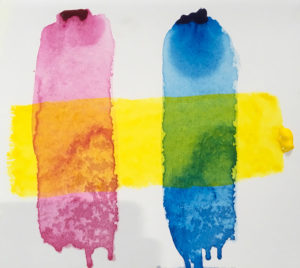
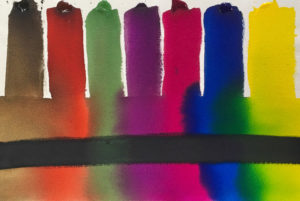
An acrylic wash is made by thinning paint with a lot of water. Thinning reduces both the amount of acrylic and pigment in the mixture. When a wash dries you end up with widely dispersed pigment particles settled down into and on the painting surface, with a very small amount of acrylic binder. With washes, pigment particles can meander and collect in concentrated areas depending on how it is applied and how absorbent or non-absorbent the substrate is. These flowing, changeable and sometimes hard to control effects, can be both challenging and exciting to work with. While you can thin our Heavy Body Acrylics with water to make washes, it is easier to use our Fluid Acrylics or High Flow Acrylics for this.
We have seen very thinned out Fluid or Heavy Body Acrylics of ours function very well in terms of film stability and water sensitivity. One can be fairly free with the amount of water used. If there is a concern about the wash being too weak a film, then a small amount of thin medium such as High Flow Medium or Fluid Matte Medium can be added. Or, a thin layer of a Medium can be used on top of the dry wash to create a more durable surface. More details about how much water can be used to thin our acrylics can be found in this article:
How Much Water Can you Safely Add to Acrylic Paint?: https://justpaint.org/how-much-water-can-you-safely-add-to-acrylic-paint/
What are Acrylic Glazes?
An acrylic glaze is made by extending paint with any transparent or translucent Medium. A glaze is a binder rich mixture typically having a very small amount of paint blended with a much larger amount of medium. Many mediums can be used to create a glaze, including thinner mediums like High Flow Medium or Glazing Liquid all the way up to very thick Gel Mediums. Opaque mediums like Molding Pastes or Pumice Gels will not work well to mix effective glazes. While traditionally glazes were thought of as thin films, acrylic glazes have much broader potential and can be thin or thick, and everything in between. You can freely blend either our Heavy Body or Fluid Acrylics or even our High Flow Acrylics with any GOLDEN transparent or translucent medium or gel medium to create glazes.
Glossy mediums dry with the greatest clarity or translucency, while semi-gloss or matte mediums will dry translucent and with some level of cloudiness due to the matting agents present. When used to make glazes, these lower sheen mediums can yield some very beautiful effects that take advantage of their foggy and misty qualities. For additional information, here are articles on encaustic effects with acrylic, and glazing with acrylics, oils and watercolors:
Encaustic Effects with GOLDEN Acrylics: http://www.goldenpaints.com/videos/encaustic-effects-with-golden-acrylics
Encaustic Look with Acrylics: https://justpaint.org/creating-an-encaustic-look-with-acrylics/
And this article also shines some light on the topic: Glazing with Acrylics, Oils and Watercolors: https://justpaint.org/glazing-with-acrylics-oils-and-watercolors/
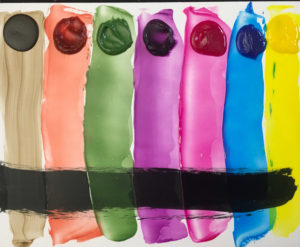
When to Wash or Glaze?
Acrylic washes work well when you want thin paint to absorb into the surface like a stain, and to create effects reminiscent of watercolor. Raw canvas, primed canvas, an absorbent ground, or paper are all suitable options for substrates where washes can create a stained effect. Washes can be used on dry or pre-moistened absorbent surfaces. In some cases, washes can be used on less absorbent surfaces. GOLDEN Wetting Agent can be added to the wash mixture or also mixed into water and used to pre-wet an absorbent surface, which can allow for deeper staining effects. Only very small amounts are necessary and Wetting Agent is optional. Often, the acrylic paint itself will include enough surfactant. Here is more information:
Wetting Agent: http://www.goldenpaints.com/technicalinfo_flreleas
Acrylic Wash and Stain Painting on Raw Canvas: https://www.youtube.com/watch?v=dHPybGEYshs
GOLDEN High Flow with Acrylic Flow Release (Wetting Agent) for staining on canvas: http://www.youtube.com/watch?v=qn0him0FiSg&list=UU7Q21sJbaAVOIylhu3E7row

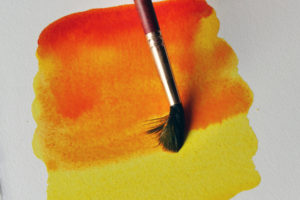
Glazes are useful when you want a translucent color effect in a discreet paint film allowing more control over the dry surface sheen, and how the paint can be handled on the surface. The viscosity of a glaze combined with the pigment held in even suspension allows for both sheer and graduated color effects, and also sharper controlled edges, depending on how you manipulate the glaze. Some of the most intense color effects can be created with glazes, especially when using certain synthetic organic colors like Quinacridones or Phthalo Blues and Greens. Glazes with these colors used over white grounds will show the very high chroma undertones and can create brighter colors than tinting with white or using full strength colors opaquely.
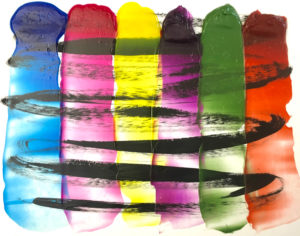
Glazes can be used on less absorbent or more absorbent surfaces. They can be thin or quite thick, applied with brushes or spreading tools such as palette knives or squeegees. They can even be poured if you use a thin medium, keeping in mind that some thin mediums will tend to craze if applied too thickly. A brushed on glaze can often dry with very visible brush marks due to the darker drying of the raised areas within the brush mark. If this is not desired, use a thinner medium to make the glaze and apply with a palette knife or other spreading tool, or a soft, flat synthetic bristle brush.
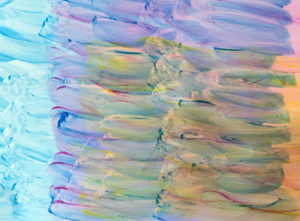
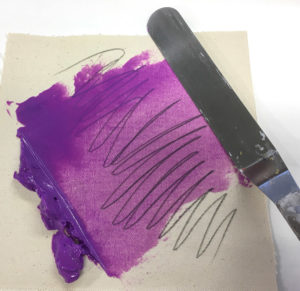
How Do I Make and Use Washes and Glazes ?
There are no rules for ratios with either water for thinning, or medium for extending, as it all depends on the level of translucency, color intensity, specific consistency and dry surface sheen. While thinning acrylic paint with water to make washes is pretty simple and direct, mixing glazes can be a bit more complex, both in the options available and in how they can be used and function in a painting. Experimentation, as always, will be the best way to learn how to use these mixtures. The natural versatility of acrylic paints and mediums allows for a wide range of uses. As mentioned at the start, most of the washes and glazes shown here were made with approximate 1/90 ratios of paint to water or medium, but the possibilities are really infinite.
Acrylic washes or glazes can be used on raw or gessoed canvas or on a range of other acrylic painting grounds. Acrylic washes can be layered much like watercolor and glazes can also be layered with a broader range of effects possible due to surface texture variations, a more discreet separation of the layers and the way light filters through translucent acrylic films. Optical color mixing is possible with both washes and glazes, and there is typically no limit to the number of layers you can use, other than diminishing color at a certain point.

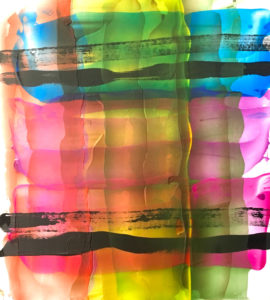
Sometimes it is best to pre-mix larger amounts of a wash or a glaze and store in plastic containers with lids, so that you have enough of the mixture to use for a painting or a series of paintings. A swatch of the glaze or brush out of the wash on the lid works well as a label and will remind you of the inevitable dry color change that occurs with glazes. You may need to first apply some Absorbent Ground on the lid to show a wash or simply attach a piece of paper or raw canvas to the lid.
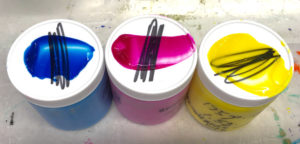
Washes are typically applied by brush but can also be applied with sponges or by dripping, pouring or splattering. Glazes can be applied with brushes when they are thin and as they get thicker, spreading tools of various sorts can create lovely, sheer and consistent veils of color. Experiment with palette knives, scrapers and squeegees.
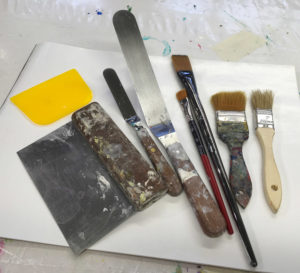
Some very interesting and beautiful effects are possible by combining and layering washes and glazes. You can work wet into wet with glazes on top of washes, or thin glazes with water to create something in-between a wash and a glaze. Very translucent glazes can be layered with more opaque painted marks to create very rich and complex surfaces and visual effects. Below are some details of paintings using various combinations of washes and glazes.
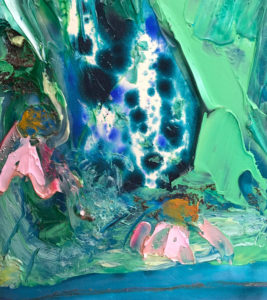
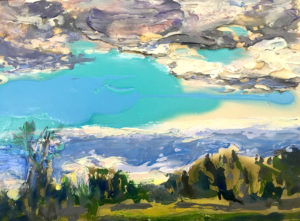
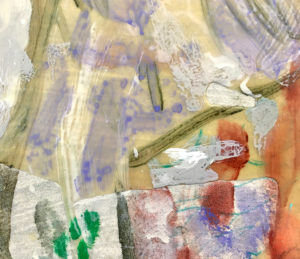
About Scott Bennett
View all posts by Scott Bennett -->Subscribe
Subscribe to the newsletter today!
No related Post

I am primarily a watercolor artist and the blending and thinning skills in this medium lend themselves primarily to practice. However, acrylics, because of the many viscosity and medium products, are an entire different story. This article has been long in coming and I think the many watercolor artists who have tried acrylics and leave them on a shelf until they can internalize the process owe you a giant hurrah. Thanks so much for this information. I’m sure you can eventually provide us with additional information as you read additional comments and help us thru the blending jungle. Thanks and regards…Alan
Hi Alan,
Thanks so much for your comments. I am very happy to hear that the information in my article is helpful, and I look forward to assisting you and others in the future!
As always, fabulous info. I’m a loyal Golden artist due to the great support (and very personal) your company offers. Keep up the good work!
Hi Barry,
Thank you for you kind comment and compliment about our company, our tech support and our Just Paint publications! We will most definitely keep up the good work!
Hi Scott, Thank you for the very informative article. I was wondering if you thought there would be an issue with using airbrush medium as a thinner for heavy body paints, not only in glazes but also as thinning agent for heavy body paints (in place of water).
Hi Wendi,
You are most welcome! Our Airbrush Medium can be used as a kind of slower drying painting medium, however, this is not its first and foremost intended use. Its main use is to extend and thin regular drying and thicker paints and mediums so they will be more easily sprayable. Having said this, we are aware that many artists seem to be choose to use this product as a slow drying medium. While it can work, it has more limitations than our other slow drying mediums, because we have added a larger amount of retarder to Airbrush Medium, and do not recommend using it by itself or in amounts over about 50%, as it may take too long to dry and may contribute to a tackier surface. For these reasons, it would not be a good idea to use it in place of water or to make very translucent glazes. Water is the best thinner for waterborne acrylics whenever wanting to make washes. If needing a very thin painting medium our High Flow Medium is best. But, it is not slow drying. A better product to use would be our Glazing liquid, if needing a slow drying medium, or perhaps our OPEN mediums, with the other idea to use additives such as our Retarder or OPEN thinner to slow drying.
Great article Scott. The acrylic wash and watercolor comparison is very frequent on public forums, and this article does much to answer many misconceptions. I like using Golden Open acrylics for paintings where I use wash and glazing techniques. The reactivating properties allow one to lift the paint in unique ways, and the pigments mingle when laying washes over freshly applied areas. As with ALL mediums, there are learning curves that are individual to that particular product. I have yet to try the Golden Fluid Acrylics, because the Open line is just magic!
Hi Steve,
Thank you! It is gratifying to hear that my article is helpful in answering many misconceptions. If you are using our OPEN acrylics for both washes and glazes I assume you are using our OPEN Mediums to mix glazes and water to make washes. I am very familiar with the reactivation properties of our OPEN Acrylics and in early testing of the paints, I found the open time of these paints pretty wonderful. I am very familiar with our Fluid Acrylics because I have been using them in my own work since we came out with them in the early 90’s. They are wonderful in the way they can easily be thinned to make washes and also easily blend with our Mediums and thicker Gel Mediums and Pastes to create a large range of mixtures with many different characteristics. For my practice they are perfect. I would encourage you to try them, and keep in mind they will try with the faster typical rate that all regular drying acrylics have. Best of luck with your work!!
As usual from Golden … fabulous and generous information on wonderful subjects
I was delighted to find more options for working with raw canvas. By the 80s Frankenthaler
had begun availing herself of all the resources of paint and painterliness etc contrasting thickened
marks standing off the surface and areas of thinner atmospheric colour etc
I am delighted with the thought of matte medium glazing and the many other ideas and techniques
you present in this fascinating article.
Hi Crissea,
Thank you for your kind compliments about my article! I have followed Helen Frankenthaler’s work for a long time, and know the surfaces you speak of. It is certainly possible to use thicker areas of acrylic paints and mediums combined with thin stained canvas areas, as acrylic is such a versatile painting medium. For any works that retain stained canvas as part of the work, it is always best to use a sturdy grade of canvas, especially as the works become larger. Cotton canvas will degrade over time and lose its tensile strength, so heavier weight canvas will last longer. Generally speaking, # 10 grade cotton duck will work fine. Anything thinner or less sturdy in terms of the weave, will be less desirable. It is also best to use well constructed stretchers and to stretch your own canvas, as this allows for more quality control.
Scott, love the color samples and incredible variety of wash/glazing information! I used to used acrylics in the 80s but have used oils since 2000 until very recently when I started re-experimenting w/acrylics, esp in re to washes & glazes – so this is extremely helpful! Can you tell me if I can still varnish over a wash? I’d be applying it to an acrylic wash over an absorbent ground (just order the 32 oz Golden container of it) on gesso primed canvas. Thanks so much! 😊
Hi Felipe,
Thanks for your kind comments about the article! I am happy to hear the information is helpful. You can varnish fully dry washes, but there can be some situations where very thinned out washes might be more water sensitive and may cause some color movement during brush application of either our Isolation Coat or Polymer Varnish. You always have the option of spray applying an Isolation Coat, or another option, if water sensitivity is present, is to spray a few coats of our Archival Varnish ( Gloss ) and then brush apply the Isolation Coat, followed by the Varnish of your choice ( either Polymer Varnish or MSA Varnish ). I mention this possibility of water sensitivity in the article and suggest this other article for more information: How Much Water Can you Safely Add to Acrylic Paint?: https://justpaint.org/how-much-water-can-you-safely-add-to-acrylic-paint/
Keep in mind that most, if not all, coatings over a wash will create significant aesthetic changes to the delicate wash surface, and you may want to test first. Having said that, we do recommend adding at least a thin medium coating to works on our Absorbent Ground as this surface can be quite delicate and prone to catching fine particles in its very porous surface. Check out our Absorbent Ground tech sheet here: https://goldenpaints.com/technicalinfo/technicalinfo_absorb
For more details about our Varnishes and best recommended application methods here are some links for you:
VARNISHING RESOURCES:https://www.goldenpaints.com/technicalinfo/technicalinfo_varnishresources
Varnish Application Guidelines: https://www.goldenpaints.com/technicalinfo/technicalinfo_varnapp1
Intro to Varnishing: https://www.goldenpaints.com/technicalinfo/technicalinfo_varnapp
Should you Varnish your Painting?: https://www.youtube.com/watch?v=bfi6H2dFlcw
Tips and Tricks for Varnishing: https://justpaint.org/tips-and-tricks-for-varnishing/
New pre-mixed Isolation Coat: https://www.goldenpaints.com/products/varnish-top-coat/protective-coatings
Isolation Coats: https://www.goldenpaints.com/technicalinfo/technicalinfo_isolationcoat
Creating a Brushable Isolation Coat: https://www.youtube.com/watch?v=6jS3Rjd5P1g
Brush Application of an Isolation Coat: https://www.youtube.com/watch?v=5gq9DJYJapE
I hope this is helpful!
Hi Scott, I have been away from painting for a while and had started several paintings with an oil wash to fix the charcoal to the canvas. The canvases have been wrapped in stored for at least 20 years. They are in good shape clean. In the meantime, I lost a lung and cannot breathe the fumes of the turpentine, so I switched to acrylic. My question is, can I paint acrylic over a light oil wash. I probably know the answer. Fat Overlene never lean over fat. However, I cannot figure out how to save the paintings since they are half finished with an oil wash the rest of the design is in charcoal. Have you got a solution for me. Do you think it be OK to paint acrylic over a light oil wash?
Sure would appreciate an email with your opinion. Since I’m stuck home can’t go out and find artist to talk to. I’m just now getting back into my art as I have been quilter for many years. Now I’m ready to paint portraits again, in acrylic.. your work is superb. I guess I just have to hear it from another artist. Maybe I should put on a ventilator and paint with oil. LOL
Hi Scott. I have a question. I am an amateur painter & tried glazing for the first time. My yellow glaze went on too thick & created dark lines that covered up part of my painting. Is there any way to “fix” this?
Hi Kimberly,
Glazes can be tricky and can take some time and practice to understand how they work. Thicker glazes will dry much darker as you have discovered, and then what looked like a pastel like color when wet can become a much darker color. This is why its a good idea to have your glazes pre-mixed as discussed in the article with a swatch on the lid so you can see the final dry color. As for how best to fix your current painting, I think the only way would be to paint over the lines with a lighter color which could be the same glaze with a touch of white added to add some opacity and lighten it up.
Hello Susan,
Yes, we are still checking for questions! Using glazes to change the value and color of certain areas of your painting in order to create a sense of pictorial space or distance can certainly be one method for doing this. And of course you can also just use opaque color as well, but this would mean painting all the various details or areas in similar values and reduced color intensity, and so glazes can be a quicker and perhaps more efficient way to do this. Keep in mind that these are painting technique or “how to paint” issues and we tend not to get into this kind of advice too much. You will have to take some time to experiment and practice with these methods to determine what works best for you. You may find that using both glazes and more opaque applications together and overlapping may be the most logical and useful way to proceed, as each painting will tend to have its own aesthetic or visual “logic”.
Hello,
Thanks for an interesting article. The ability to paint with translucent layers (and to apply many of those in a short time) is one of the things I like most about acrylics.
I don’t think I’ve ever heard the sink-in/sit-on-top distinction made between washes and glazes so I’ve learnt something today. I would probably have called any thin watery mix a wash, and subsequent layers of that mix I would have called a glaze. I shall now restrict the use of ‘glaze’ to watery mixes on top of synthetic yupo type paper.
Hi Tina,
Thank you! I agree that acrylics are wonderful for creating translucent layers and glazes and the faster drying enables faster work and potential for more layers within a shorter period of time. I wanted to make this distinction between Washes and Glazes and keep the terms within the material realm. You are correct in that washes can be layered and one could refer to those translucent washes as glaze like or perhaps even as glazes but then this becomes confused with a glaze made with a medium, which performs differently. So I thought it a good idea to define them in terms of the materials used to create them. Washes are typically only used or at least used best on more absorbent surfaces like paper or raw canvas or an absorbent acrylic ground, and each subsequent wash soaks in to some extend, where as a glaze layer remains very separate and distinct. As for Yupo paper, we have seen poor adhesion of acrylics to this substrate. We know watercolorists use it and it does enable some very cool effects, but should always be under glass unless some kind of reliable topcoat can be applied that adheres to it. Our testing showed poor adhesion with acrylics. And these washes that don’t soak in but layer on top could act more “glaze like”.
Hi, thank you very much for this article. I have used a glaze before to protects my background, as I make mistakes and the glaze allows me to remove the mistake without spoiling the background. Unfortunately I have lost the recipe and althouigh have tried different ratios of matte glaze to water, I have not found the correct one. Can you please help. ( Although I am a beginner, I am 81 yrs. old so my memory is not the best)
Hello, Joy.
Thank you for your question!
Acrylic mediums, such as Fluid Matte Medium may be used as a sealing layer (what you are calling a glaze I believe) to serve as an isolating layer before continuing to work over it. If you’d like to contact us directly, you can email us at [email protected], or give us a call at 1-800-959-6543 and ask for the Material & Application Specialist Department. We would be happy to assist!
Regards,
Mike at GOLDEN